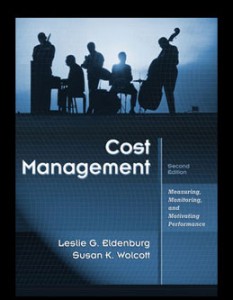Instant download Test Bank for Cost Management Measuring Monitoring and Motivating Performance, 2nd Edition: Eldenburg pdf docx epub after payment.

Product details:
- ISBN-10 : 0470769424
- ISBN-13 : 978-0470769423
- Author:
Cost accounting has become an increasingly important tool for managers and accountants alike. The second edition helps them achieve professional success by bridging the gaps between knowledge, skills and abilities. It has been revised to focus on decision-making while still examining the procedural detail. It also emphasizes the analysis and application of concepts. Additional examples and illustrations draw comparisons between government and manufacturing. Real-world scenarios and ethical decision-making sections demonstrate how the material is applied. Accountants and managers will also view Excel spreadsheets to give them a better understanding of the material.
Table of contents:
- Chapter 1: The Role of Accounting Information in Management Decision Making
- MOTOROLA’S IRIDIUM PROJECT: LOOK BEFORE YOU LEAP
- STRATEGIC MANAGEMENT AND DECISION MAKING
- Organizational Vision
- Organizational Core Competencies
- Organizational Strategies
- Operating Plans
- Actual Operations
- Measuring, Monitoring, and Motivating Performance
- LEVERS OF CONTROL
- Belief Systems
- Boundary Systems
- Diagnostic Control Systems
- Interactive Systems
- COST ACCOUNTING AND STRATEGIC MANAGEMENT
- Management Accounting and Financial Accounting
- A Brief History of Cost Accounting
- Strategic Cost Management
- INFORMATION SYSTEMS AND STRATEGIC MANAGEMENT
- Internal and External Reports
- Improvements in Information for Management Decision Making
- Business Intelligence and Process Management Systems
- RELEVANT INFORMATION FOR DECISION MAKING
- Relevant and Irrelevant Cash Flows
- Relevance of Income Statement Information
- SNOW-BLADE SNOWBOARDS: IDENTIFYING RELEVANT COSTS
- Importance of Identifying Relevant Information
- BUSINESS RISK
- Risk Management
- Business Risk and Cost Management
- DECISION-MAKING BIASES
- RISK OF BIASED DECISIONS: Nonrational Escalation of Commitment
- QUALITY OF MANAGEMENT DECISION-MAKING
- ETHICAL DECISION MAKING
- Conflicting Interests
- Motive for Ethical Behavior
- FOCUS ON ETHICAL DECISION MAKING: Ethical Considerations in Outsourcing Decisions
- Reputation Effects of Suppliers’ Unethical Actions
- Analyzing the Ethics of a Decision
- APPENDIX 1A Steps for Better Thinking: A Decision-Making Process
- SUMMARY
- KEY TO SYMBOLS
- Self-Study Problems
- Key Terms
- QUESTIONS
- EXERCISES
- PROBLEMS
- MINI-CASES
- Chapter 2: The Cost Function
- FLYING LOW DURING AN ECONOMIC DOWNTURN
- IDENTIFYING RELEVANT COSTS FOR A DECISION
- Relevant Costs for a Cost Object
- Identifying Relevant Costs from the Accounting System
- Direct and Indirect Costs
- Opportunity Costs
- Sunk Costs
- COST BEHAVIOR
- Variable, Fixed, and Mixed Costs
- Classifying Costs
- Relevant Range
- Cost Functions
- Cost Driver
- Identifying Potential Cost Drivers
- No Apparent Cost Driver
- Discretionary Costs
- Economies of Scale
- FOCUS ON ETHICAL DECISION MAKING: Discretionary Costs
- Ethics and Pharmaceutical Advertising
- INFORMATION USED TO ESTIMATE COSTS
- COST ESTIMATION TECHNIQUES
- Engineered Estimate of Cost
- Analysis at the Account Level
- Scatter Plots
- Two-Point Method
- High-Low Method
- RISK OF BIASED DECISIONS: Insensitivity to Sample Size
- ESTIMATING THE COST FUNCTION
- SMALL ANIMAL CLINIC (PART 1): CREATING A COST FUNCTION
- Identify Relevant Costs and Obtain Information Needed for Estimation
- Categorize Costs, Apply Cost Estimation Techniques, and Estimate Future Costs
- Combine All Relevant Cost Estimates
- Estimating Profit
- REGRESSION ANALYSIS
- Simple Regression Analysis
- Interpreting Simple Regression Results
- SMALL ANIMAL CLINIC (PART 2): TWO-POINT METHOD AND REGRESSION ANALYSIS
- Revised Analysis of the Treatment Supplies Cost
- Quarterly Data
- Scatter Plots
- Two-Point Method
- Simple Regression Analysis
- Revised Cost Estimate
- Review of Methods, Total Cost Function
- STRATEGIC RISK MANAGEMENT: Small Animal Clinic (Part 2)
- Cost Estimation Accuracy and Strategies
- USES AND LIMITATIONS OF COST ESTIMATES
- Cost Estimation and Managerial Decision Making
- Common Errors in Estimating Relevant Costs
- Quality of Estimation Techniques
- Reliance on Cost Estimates
- APPENDIX 2A REGRESSION ANALYSIS-ADDITIONAL TOPICS
- MULTIPLE REGRESSION ANALYSIS
- Choosing Cost Drivers for Multiple Regression
- PRINT MASTERS PRINT SHOP: USING MULTIPLE REGRESSION TO ESTIMATE A COST FUNCTION
- Scatter Plots and Simple Regression Results
- Multiple Regression Analysis
- REGRESSION ANALYSIS ASSUMPTIONS
- ADDITIONAL REGRESSION ANALYSIS CONSIDERATIONS
- Stepwise Linear Fixed Costs
- Piecewise Linear Variable Costs
- Data Limitations
- APPENDIX 2B: Learning Curves
- SUMMARY
- KEY TO SYMBOLS
- Self-Study Problems
- Key Terms
- QUESTIONS
- EXERCISES
- PROBLEMS
- MINI-CASES
- Chapter 3: Cost-Volume-Profit Analysis
- WIRED OR WIRELESS: ADJUSTING TO NEW MARKETS
- COST-VOLUME-PROFIT ANALYSIS
- Profit Equation and Contribution Margin
- CVP Analysis in Units
- CVP Analysis in Revenues
- CVP for Multiple Products
- Breakeven Point
- Cost-Volume-Profit Graph
- CVP with Income Taxes
- DIE GEFLECKTE KUH EIS (THE SPOTTED COW CREAMERY) (PART 1): CVP ANALYSIS WITH INCOME TAXES
- Estimating the Cost Function
- Estimating After-Tax Profit
- Calculating Revenues to Achieve Targeted After-Tax Profit
- RISK OF BIASED DECISIONS: Optimism Bias
- PERFORMING CVP ANALYSES WITH A SPREADSHEET
- CVP Calculations for a Sales Mix
- CVP Sensitivity Analysis
- Discretionary Expenditure Decision
- Planning, Monitoring, and Motivating with CVP
- DIE GEFLECKTE KUH EIS (THE SPOTTED COW CREAMERY) (PART 2): THE INFLUENCE OF SALES MIX ON PROFITABILI
- STRATEGIC RISK MANAGEMENT: Spotted Cow Creamery (Part 2)
- ASSUMPTIONS AND LIMITATIONS OF COST-VOLUME-PROFIT ANALYSIS
- Business Risk and Quality of Input Data
- Quality of CVP Technique
- CVP for Nonprofit Organizations
- SMALL ANIMAL CLINIC: NOT-FOR-PROFIT ORGANIZATION CVP ANALYSIS WITH TWO RELEVANT RANGES
- Breakeven Compared to Budget
- Potential Investment in New Equipment
- Calculating and Analyzing Targeted Activity Level
- CVP Adjusted for Change in Relevant Range
- MARGIN OF SAFETY AND DEGREE OF OPERATING LEVERAGE
- Margin of Safety
- Degree of Operating Leverage
- Using the Degree of Operating Leverage to Plan and Monitor Operations
- FOCUS ON ETHICAL DECISION MAKING: Temporary Labor
- Ethics and Temporary Labor
- SUMMARY
- KEY TO SYMBOLS
- Self-Study Problems
- Key Terms
- QUESTIONS
- EXERCISES
- PROBLEMS
- MINI-CASES
- Chapter 4: Relevant Information for Decision Making
- INTERNATIONAL OUTSOURCING: THE GOOD, THE BAD, AND THE CONTROVERSIAL
- RELEVANT INFORMATION FOR DECISION MAKING
- Process for Identifying and Analyzing Relevant Information
- Operating Decision Examples
- SPECIAL ORDERS
- Quantitative Rule for Special Order Decisions
- BARKLEY BASKETBALLS: SPECIAL ORDER
- Quantitative Analysis
- Qualitative Analysis
- Strategic Prioritization
- STRATEGIC RISK MANAGEMENT: Barkley Basketballs
- Special Orders and Pricing Policies
- Qualitative and Risk Factors for Special Order Decisions
- KEEP OR DROP DECISIONS
- Quantitative Rule for Product and Business Segment Keep or Drop Decisions
- HOME AIDE SERVICES: KEEP OR DROP
- Quantitative Analysis
- Qualitative Analysis
- Strategic Prioritization
- STRATEGIC RISK MANAGEMENT: Home Aide Services
- The Business Risk of Dropping a Product
- Customer Profitability
- RISK OF BIASED DECISIONS: Confirmation Bias
- Costs of Carrying Inventory
- Qualitative and Risk Factors for Keep or Drop Decisions
- INSOURCE OR OUTSOURCE (MAKE OR BUY) DECISIONS
- Quantitative Rule for Insource or Outsource Decisions
- ROADRUNNER PUBLISHERS (PART 1): INSOURCE OR OUTSOURCE
- Quantitative Analysis
- Qualitative Analysis
- Strategic Prioritization
- Qualitative and Risk Factors for Outsourcing Decisions
- FOCUS ON ETHICAL DECISION MAKING: Offshoring Surgery
- The Ethics of International Medical Outsourcing
- PRODUCT EMPHASIS DECISIONS
- Quantitative Rule for Product Emphasis Decisions
- Theory of Constraints and Constrained Resources
- Quantitative Rule for Choosing the Product Mix When Resources Are Constrained
- Quantitative Rule for Relaxing Constraints for One or Two Products
- ROADRUNNER PUBLISHERS (PART 2): CONSTRAINED RESOURCE
- Qualitative Analysis
- Quantitative Analysis
- Strategic Prioritization
- STRATEGIC RISK MANAGEMENT: Roadrunner Publishers (Part 2)
- Reducing the Risk of Lost Sales
- PRODUCT EMPHASIS: MULTIPLE RESOURCE CONSTRAINTS AND MULTIPLE PRODUCTS
- Quantitative Rule for Maximizing Contribution Margin with Multiple Constraints and Multiple Products
- BERTRAM GOLF CARTS: MULTIPLE CAPACITY CONSTRAINTS AND MULTIPLE PRODUCTS
- STRATEGIC RISK MANAGEMENT: Bertram Golf Carts
- Risky Assumptions
- METHODS FOR RELAXING CONSTRAINTS
- Use Constrained Resources More Efficiently
- Increase Available Resources
- Qualitative and Risk Factors for Product Emphasis and Constrained Resource Problems
- QUALITY OF OPERATING DECISIONS
- Quality of Information
- Strategic Alignment
- Decision-Maker Bias
- Opportunity Costs
- ROADRUNNER PUBLISHERS (PART 3): INSOURCE OR OUTSOURCE WITH OPPORTUNITY COSTS
- Business Risk and Sensitivity Analysis
- Control System Incentive and Behavioral Effects
- Appendix 4A: Using Excel Solver for Product Emphasis and Constrained Resource Decisions
- 1. Determine the Objective (Target) Function
- 2. Create Constraint Functions
- 3. Set Up an Excel Spreadsheet
- 4. Use Excel Solver to Maximize the Objective Function
- 5. Interpret the Solver Output
- SUMMARY
- KEY TO SYMBOLS
- Self-Study Problem
- Key Terms
- QUESTIONS
- EXERCISES
- PROBLEMS
- MINI-CASES
- Chapter 5: Job Costing
- BOMBARDIER: CUSTOM MANUFACTURING
- ASSIGNING PRODUCT COSTS TO INDIVIDUAL GOODS OR SERVICES
- Product Costs
- Process Costing
- Job Costing
- JOB COSTING IN MANUFACTURING
- Assigning Direct Costs
- Computerized and Manual Job Costing Systems
- ALLOCATING OVERHEAD
- Actual and Normal Costing
- ALUMINUM BENDERS (PART 1): ALLOCATING OVERHEAD COSTS IN JOB COSTING
- Evaluating Overhead Cost Pools and Allocation Bases
- Understanding the Overhead Cost Allocation Method
- GENERAL LEDGER ENTRIES FOR A MANUFACTURER
- Overapplied and Underapplied Overhead
- SERVICE SECTOR JOB COSTING
- NIGHTHAWK, LLP: JOB COSTING IN A LAW FIRM
- Estimated Job Costs and Price
- Competitor’s Job Costs and Price
- Monitoring Job Costs
- STRATEGIC RISK MANAGEMENT: Nighthawk, LLP
- Relevance of Fixed Costs
- JOB COST INFORMATION, DECISIONMAKING, AND INCENTIVES
- Allocated Overhead Costs and Decision Making
- ALUMINUM BENDERS (PART 2): JOB COSTS RELEVANT FOR DECISION MAKING
- Qualitative Factors
- Judgment and Uncertainties in Job Costing System Design
- Measuring Job Costs for Diagnostic Control
- Allocated Overhead and Relevant Costs
- RISK OF BIASED DECISIONS: Hindsight Bias
- FOCUS ON ETHICAL DECISION MAKING: Overbilling Clients for Expenses
- Tracing Rebates and Discounts Directly to Jobs
- SPOILAGE, REWORK, AND SCRAP IN JOB COSTING
- Normal and Abnormal Spoilage
- ALUMINUM BENDERS (PART 3): ASSIGNING SPOILAGE COSTS
- Rework
- Scrap
- PRODUCTION QUALITY AND BEHAVIOR IMPLICATIONS
- Spoilage Opportunity Costs
- Investing in Quality
- Effect of Accounting on Manager Behavior
- External Monitoring
- SUMMARY
- KEY TO SYMBOLS
- Self-Study Problems
- Key Terms
- QUESTIONS
- EXERCISES
- PROBLEMS
- MINI-CASES
People also search:
Cost Management Measuring Monitoring and Motivating Performance
Cost Management Measuring Monitoring and Motivating Performance Eldenburg
Cost Management Measuring Monitoring and Motivating Performance Eldenburg 2nd
Cost Management Measuring Monitoring and Motivating Performance Eldenburg 2nd Test Bank
Test Bank for Cost Management Measuring Monitoring and Motivating Performance, 2nd Edition: Eldenburg Download





